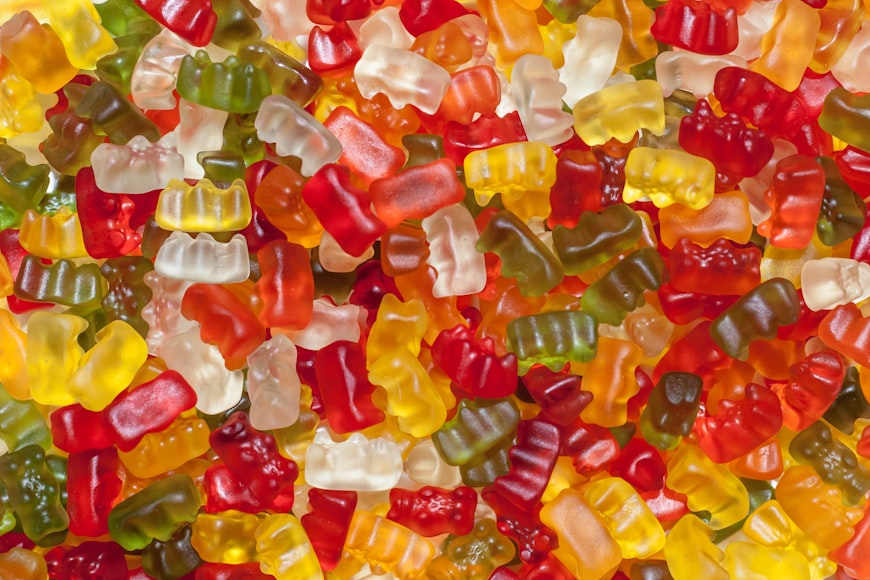If you’re anything like us, you can’t help but adore these colorful, chewy, and oh-so-sweet little treats. They’ve been a staple in candy jars, at movie theaters, and even in your favorite Delta 8 gummies dispensary. But have you ever stopped to wonder how these delightful jelly candies came to be? Well, you’re in for a treat (pun intended) as we dive into the fascinating history of our favorite candy – the gummy bear! So grab a handful of these chewy delights, sit back, and let’s embark on a sugar-coated journey together.
Table of Contents
Origins of the Gummy Bear
Gummy bears trace their roots all the way back to Germany, where they were created by a clever confectioner named Hans Riegel Sr. in the early 20th century. Riegel, recognizing the potential for a new kind of candy, founded a small company in 1920 called Haribo, which stands for Hans Riegel Bonn – the city where it all began.
The idea for the gummy bear’s iconic shape was inspired by the dancing bears often seen at European festivals and fairs. Riegel wanted to capture the fun and whimsy of these bears in a bite-sized, chewable treat. Thus, the gummy bear was born!
The original gummy bear recipe was quite simple, yet perfectly balanced. The main ingredients included sugar for sweetness, glucose syrup for texture, flavorings to create a fruity taste, gelatin for that signature chewiness, and fruit juice concentrate to provide a hint of natural fruitiness. These ingredients combined to create a candy that was unlike anything else on the market at the time.
As gummy bears gained popularity in Germany, their fame quickly spread to neighboring countries. The unique texture and delightful flavors captured the hearts (and taste buds) of candy lovers across Europe, setting the stage for the gummy bear’s eventual journey around the globe.
Gummy Bears Go Global
The gummy bear’s irresistible charm didn’t take long to cross the Atlantic and reach the United States. In the 1980s, the Herman Goelitz Candy Company, which later became the Jelly Belly Candy Company, started importing gummy bears from Germany. They recognized the potential of these chewy treats and soon began producing their own line of gummy bears under the Black Forest brand, named after the picturesque region in Germany where the Haribo gummy bears originated.
As gummy bears continued to gain a loyal following in the U.S., their popularity spread to other parts of the world. Today, you can find gummy bears in virtually every corner of the globe, manufactured by a wide array of brands, each with their own unique spin on the classic candy. Some well-known names include Trolli, Albanese, and YumEarth, all offering a variety of flavors and styles to cater to the diverse tastes of gummy bear enthusiasts worldwide.
The global appeal of gummy bears can be attributed to their winning combination of bright colors, enticing flavors, and that satisfyingly chewy texture. This universal appeal has ensured that gummy bears remain a beloved candy in countless countries, transcending cultural and geographical boundaries, and bringing joy to people of all ages.
Modern Gummy Bear Innovations
The world of gummy bears has evolved and expanded over the years, giving rise to a myriad of new flavors, shapes, and variations to delight candy fans everywhere. Sour gummy bears have become a favorite for those who crave a tangy twist, while gummy worms and gummy rings provide a fun change from the traditional bear shape.
Candy makers have also embraced the growing demand for vegan and vegetarian options by creating gelatin-free gummy bears. By using plant-based alternatives like pectin, agar-agar, or starch, they’ve managed to maintain the chewy texture we love while catering to different dietary preferences.
In addition to addressing dietary concerns, gummy bear manufacturers have branched out to include sugar-free and low-sugar options for those watching their sugar intake. Moreover, vitamin-infused gummy bears have emerged as a popular way for children and adults alike to get their daily dose of essential nutrients in a tasty, candy-like form.
Gummy bears have even found their way into pop culture, with Disney’s animated television series “Adventures of the Gummi Bears” and the viral “Gummy Bear Song” capturing the hearts of millions. These innovations and adaptations demonstrate the enduring popularity of gummy bears and the candy industry’s commitment to keeping our favorite jelly treat fresh and exciting.
Conclusion
As we’ve explored the fascinating history of gummy bears, it’s clear that these delightful little candies have captured our hearts and taste buds for over a century. From their humble beginnings in Germany to their global domination, gummy bears have proven to be a timeless and versatile treat. With countless flavors, shapes, and dietary options available, there’s a gummy bear for everyone to enjoy. So the next time you indulge in these chewy, fruity morsels, take a moment to appreciate their rich history and the sweet journey that brought them into your hands. Here’s to the gummy bear – long may it reign!




